Articles
US - China
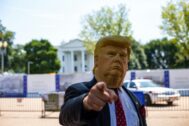
US - China
May — December 2024Trump’s Return Scrambles Outlook
US-China relations through 2024 remained marked by a paradox. On the one hand, ties displayed a distinct stabilization. The two sides translated their leaders’ modest “San Francisco Vision” into reality. Cabinet officials and the numerous working groups met in earnest and produced outcomes, functional cooperation was deepened though differences emerged, sensitive issues were carefully managed, and effort was devoted to improving the relationship’s political optics. US electoral politics, or threat of Chinese interference in the elections, did not materially impinge on ties. On the other hand, the negative tendencies in US-China relations deepened. With its time in office winding down, the Biden administration went into regulatory overdrive to deepen the “selective decoupling” of the two countries’ advanced technology ecosystems. China methodically responded in kind using its now-robust economic lawfare toolkit. The chasm in strategic perceptions remained just as wide. Donald Trump’s return to the Oval Office portends a period of disruptive unpredictability in ties, although “Tariff Man” Trump can reliably be expected to enact additional impositions on Chinese imports.
Two years to the day that they met on the sidelines of the G20 summit in Bali, Indonesia to place a floor under their troubled relationship and initiate a process of emplacing guardrails, Joe Biden and Xi Jinping met for their third in-person meeting as presidents in Lima, Peru, on the sidelines of the APEC Economic Leaders Meeting. In Lima, the two presidents took stock of the gradual rehabilitation of ties over the past two years, despite its early interruption by the balloon incident, and pledged to consolidate the fragile stability and make the relationship more predictable. They also patted themselves for harvesting some of the low-hanging fruit since their summit in Woodside, California, 12 months ago. US-China relations have made important incremental progress over the past 18 months, starting with Secretary of State Antony Blinken’s visit to Beijing in June 2023 (Blinken returned to Beijing again this April). In Spring 2023, aside from meetings of their senior-most officials, there was practically no active communication channel between the two sides. Fast forward to today and there are more than 20 dialogue frameworks that span the range from diplomacy, security, economy, trade, fiscal affairs, finance and military to counternarcotics, law enforcement, agriculture, climate change, and people-to-people exchanges.

Figure 1 US President Joe Biden and Chinese President Xi Jinping greet one another prior to a bilateral meeting on Saturday, Nov. 16, 2024 in Lima, Peru. Photo: Official White House Photo by Oliver Contreras
In Spring 2023, the US Treasury Department was sanctioning Chinese entities for their involvement in supplying chemical precursors to US-bound fentanyl trafficking networks. Today, 55 dangerous synthetic drugs and precursor chemicals have been class scheduled by Beijing, online platforms and pill presses shut down, and arrests connected to the illicit chemical industry made. Reciprocally, China’s Ministry of Public Security-linked Institute for Forensic Studies has been delisted from the Entity List—a rare case of an adversary state entity being delisted without any underlying change in the listed reason for its blacklisting.
In Spring 2023, US-China people-to-people as well as academic ties were frail, having suffered body blows stemming from the polemics associated with the origins of the COVID-19 virus and the Justice Department’s earlier “China Initiative.” There were only 12 weekly roundtrip passenger flights in service. Today, the two sides are on the verge of renewing their landmark Science and Technology Agreement (STA), the first major agreement to be signed by the two governments following the re-establishment of diplomatic relations in January 1979, pandas are returning to zoos in San Diego, Washington, DC and San Francisco, the number of roundtrip passenger flights has risen to 50 (prior to COVID-19, the number exceeded 150), and the health authorities of the two countries recently held their first ministerial-level dialogue in over seven years. The cases of “wrongfully detained” Americans have been resolved (although many others remain on exit bans), reciprocal repatriations of illegal migrants and fugitives have been conducted, and the Mainland’s Level 3 travel advisory status (Reconsider Travel) has been lowered to Level 2 (Exercise Increased Caution) by the State Department. For his part, President Xi has committed to inviting 50,000 young Americans to China on exchange and study over the next half-decade.

Figure 2 A screenshot from a Smithsonian National Zoo video showing the FedEx truck driving through Washington, DC transporting two pandas newly arrived from China on October 15, 2024. Photo: National Zoo via X/Twitter
In Spring 2023, US-China climate change discussions—a mutually beneficial area of cooperation – were at a standstill and would only resume after the visit to Beijing by Special Climate Envoy John Kerry in July 2023. Today, the US-China bilateral Working Group on Enhancing Climate Action in the 2020s has met twice and, in keeping with their Sunnylands Statement of November 2023, the two parties jointly hosted a Methane and Other Non-CO2 Greenhouse Gases Summit at COP 29 in Baku, Azerbaijan. In Spring 2023, the idea of hosting exchanges on AI hadn’t even been broached, even as US and Chinese organizations were moving forward with transformative breakthroughs in Generative AI. Today, the two sides have begun a constructive and candid policy dialogue on AI, co-sponsored each other’s resolutions on AI at the UN General Assembly, and affirmed the need to ensure that unsupervised AI must not allowed to dictate command-and-control of critical weapon system – especially the decision to use a nuclear weapon. The fear that China would be treated as a political football during the US election season or that it would interfere in the elections using disinformation operations did not materialize either (although there may have been interference in down-ballot races).
For all the positives that have flowed from their newly established or restarted dialogue frameworks, not all conversations ended in constructive outcomes. This is understandable. As the “new normal” in US-China relations takes shape, there is no one typology of interaction that can cut across the various “baskets” of US-China issues. A complex relationship demands complex choices that are built as much on ideology and values as much on interests, objectivity and realism.
Mil-Mil Conversations Go Sideways on Strategic Arms Proliferation Concerns
The decision to restart mil-mil communications at the Biden-Xi Woodside summit in November 2023 was a bright spot in bilateral ties, to the extent that “jaw-jaw” is vastly preferable to “war-war.” Mil-mil ties had been suspended by China, it bears remembering, following Speaker Pelosi’s visit to Taipei in August 2022. This included the Military Maritime Consultative Agreement (MMCA) talks, an operational safety dialogue between US INDOPACOM and PLA naval and air forces, which had convened regularly since 1998. The full range of institutionalized high-level mil-mil communications stand restored as of this writing.
In January and September 2024, the 17th and 18th editions of the Defense Policy Coordination Talks, an annual deputy assistant secretary level policy dialogue, were respectively conducted. The MMCA working group met earlier in April and again in November, and a theater commanders video-teleconference featuring the Commander of the US Indo-Pacific Command and the PLA’s Southern Theater Commander was held in early-September (the two met later in September at the Indo-Pacific Chiefs of Defense Conference in Hawaii). Topping these engagements was the first in-person meeting between the two countries’ defense chiefs, Secretary Lloyd and Minister Dong, in a year-and-a-half on the margins of the Shangri La Dialogue (SLD) in late-May. While both sides had tough words for the other in their SLD remarks, they also agreed to convene a crisis communications working group by the end of 2024. For added measure, National Security Advisor Sullivan was afforded the opportunity to meet the Vice-Chairman of the Party’s Central Military Commission (CMC), Zhang Youxia, during his late-August visit to Beijing, the first such NSA-CMC vice chair meet in eight years.
The mil-mil communications were wholesome but could not mask the wide chasm between the two sides on strategic arms-racing and deterrence concerns. It was reported in August that Biden had reoriented a highly classified US nuclear strategic plan, the Nuclear Employment Guidance, in March 2024 to account for an era of multiple nuclear-armed adversaries in the context of China’s rapidly growing nuclear arsenal. Whether linked or not, China discontinued the bilateral arms control and nonproliferation consultations in July (lamely using Taiwan arms sales card as an excuse) and, later that month, unleashed broadsides against AUKUS’ nuclear submarine cooperation pillar as well as NATO’s nuclear sharing arrangements (it issued a No-first-use Nuclear Weapons Initiative too). It also conducted its first ICBM test in 44 years in late-September, with the projectile splashing down in the South Pacific. The US and China also clashed over the deployment of the Typhon Mid-Range Capability missile system in the Philippines. The US side cautioned the PLA for its dangerous, coercive, and escalatory tactics in the South China Sea which could trigger Article V of the US-Philippines Mutual Defense Treaty; the Chinese foreign ministry spokesperson admonished the US side for the first deployment of a strategic offensive weapon system outside its territory and in the Asia-Pacific since the end of the Cold War.
Careful Management on Taiwan Amidst Lobbing of Rhetorical Salvos
The Taiwan Question remained a bone of contention in US-China relations during the mid and latter part of 2024, to nobody’s surprise. In early-May, China’s foreign ministry spokesperson blasted Secretary Blinken’s encouragement as well as that of seven other allied nations to the WHO to invite Taiwan as an observer at the 77th World Health Assembly meeting. Later that month, the ministry spokesperson “deplore[d] and oppose[d]” Blinken’s note of felicitation to Lai Ching-te on his inauguration as president of the self-governing island. Lai had angered Beijing by noting that “the PRC and the ROC are not subordinate to each other” in his inaugural address. He was called out by name; treatment that took Beijing three years to mete out to his predecessor Tsai Ing-wen.
The Biden administration, for its part, was critical of the PLA’s Joint Sword 2024 A and B military exercises that were conducted in the wake of Lai’s inaugural address in May and his “Double Ten Day” address in October, respectively. Joint Sword 2024-A had focused on seizing the initiative in the Taiwan Strait battlefield, with the training content aimed at precision strikes on critical land, air and sea targets; Joint Sword 2024-B featuring the PLA Navy and the Coast Guard sought to execute a blockade of ports and other key locations. The exercises were denounced as “irresponsible, disproportionate and destabilizing.” The Biden administration also strongly condemned the June 2024 judicial guidelines issued by China’s Supreme People’s Court which imposes criminal punishments on “diehard Taiwan independence separatists” for conducting or inciting secession, noting that threats and legal warfare would not achieve peaceful resolution of cross-strait differences. And in conjunction with like-minded ANZUS, NATO and Japanese government allies, the US State Department sought to develop a common front to debunk China’s conflation and “mischaracterization” of UNGA Resolution 2758 with its “One China Principle.” China’s foreign ministry was having none of it, and political parties at the National Assembly in Taipei too were unable to arrive at a consensus on this point. All along, the Biden administration maintained a consistent clip of arms sales to the island, including by utilizing presidential drawdown authority, as well as periodic transits through the Taiwan Strait in international waters and airspace. China, for its part, built out its Taiwan arms sales-related list of sanctioned US parties under the framework of its Anti-Foreign Sanctions Law.

Figure 3 A schematic diagram of the area of the military exercise “Joint Sword 2024B,” released by the Eastern Theater Command. Photo: Ministry of National Defense of the People’s Republic of China, Public Domain
Tit-for-tat skirmishes between the two sides were not the whole story on the Taiwan Question. In Lima, Peru, Biden again assured his counterpart that the US does not support Taiwan independence (Xi had attempted—unsuccessfully—in Woodside to alter the phraseology to “oppose Taiwan independence’) and added that the US does not use the Taiwan card to compete or contain China. More broadly, Biden yet again reemphasized his “Five Noes’: that the US does not seek a Cold War with China; does not seek to change China’s system; the revitalization of its alliances is not directed at China; does not support Taiwan independence; and does not seek conflict with China. Whether believed or not in Beijing, these assurances offer a steadying framework for future-oriented ties.
Playing Cleanup on Advanced Technologies Decoupling
In an important speech in September 2022, NSA Jake Sullivan had listed three “families of technologies” —computing related technologies; biotechnologies and biomanufacturing; clean energy technologies—as “force multipliers” that would define the geopolitical landscape of the 21st century. Given their foundational nature, the US would seek to “maintain as large a lead as possible” over adversary nations, including by resorting to a “small yard, high fence” approach on strategic trade controls. Following the speech, the US Commerce Department issued an expansive regulation that instituted controls on China’s access to advanced computing chips as well as semiconductor manufacturing equipment essential to producing such chips.
With the clock winding down on its term in office, the Biden administration maintained its frenetic rulemaking pace, issuing a number of regulations in quick succession to deepen the “selective decoupling” of the two economies’ advanced technology ecosystems. On Sept. 23, the administration released a Proposed Rule to secure the supply chain for connected vehicles, which prohibits the import of Chinese hardware and software integrated into vehicle connectivity system (VCS) and software integrated into automated driving system (ADS). VCS is the set of systems that allow the vehicle to communicate externally, including telematics control units, Bluetooth, cellular, satellite, and Wi-Fi modules. The ADS includes the components that collectively allow a highly autonomous vehicle to operate without a driver behind the wheel. The Proposed Rule follows an Advanced Notice of Proposed Rulemaking (ANPRM) issued earlier this February.
On Oct. 29, the US Justice Department issued a massive 422-page proposed rule to prevent access to Americans’ bulk sensitive personal data as well as government-related data by countries of concern, such as China. The rule proposes to establish a new national security-based regulatory regime governing the collection and transfer of personal data. Two types of commercial transactions between a “US person” and a “country of concern” are to be prohibited – transactions involving “data brokerage” (with the term defined broadly) and transactions involving human genomic data. The proposed regulation contains an exemption for certain data transfers in connection with biopharmaceutical clinical investigations and post-marketing surveillance data. The Proposed Rule follows a White House executive order accompanied by an ANPRM issued earlier this March. It also follows instances of damaging cyberespionage breaches by China-linked hackers, which include the infiltration of US broadband providers” networks to sweep up the private communications of hundreds of thousands of Americans as well as access the “lawful intercept” system maintained by the Justice Department to place wiretaps on suspected Chinese spies in the US. Earlier in July, the “Five Eyes” countries, joined by Germany and Japan and South Korea for the first time, had issued a rare joint advisory attributing malicious cyber activities to China. President Xi, for his part, disavowed any such conduct in his Lima meeting with Biden, with his foreign ministry spokesperson having earlier thrown the ball back into the US’ court.
Also on Oct. 29, the US Treasury Department released a voluminous final rule to prohibit outbound investment in semiconductors and microelectronics, quantum information technologies, and AI systems to China. The purpose of the Outbound Order is to shut down a pathway for Beijing to exploit the “intangible benefits” – including enhanced standing and prominence, managerial assistance, investment and talent networks, market access, and enhanced access to additional financing – that accompany the flow of US investments to China. The order marks the first instance of the US government controlling outbound capital flows for national security reasons. And while the regulation is framed as addressing capital flows, it effectively regulates the coverage of “greenfield” and “brownfield” investments in these national security technologies and products, too. The Final Rule follows a White House Executive Order issued in August 2023 and a Proposed Rule issued earlier this July.
Finally, on Dec. 2, the US Commerce Department issued a final rule that upgrades the existing controls on China’s access to semiconductor manufacturing equipment so as to impair its capability to produce advanced node semiconductors. Twenty-four types of semiconductor manufacturing equipment and three types of software tools are to be additionally denied to Chinese end-users. Beijing response to the measure was swift. On Dec. 3, it announced a ban on several minerals essential to semiconductor, communications and military technologies, as well as a prohibition on exports of dual-use items to US military end users. Alongside the semiconductor manufacturing equipment rule, the US Commerce Department also imposed controls on the transfer of high-bandwidth memory (HBM) chips, which are crucial for accelerating AI training and inference as well as added 140 entities spanning tool companies, chip fabs and investment firms to the Entity List. Earlier this May, a number of Chinese quantum technology companies and research institutes had been added, too, to the List. Overall, the number of Chinese entities placed in the Entity List during the 2018-2023 period have increased over 300% (from 218 to 787). As for license applications submitted that involve a Chinese Entity List-ed party, they increased from five in 2018 to a high of 1,751 in 2021, with approximately 33 percent of applications either denied or revoked.
In addition to these advanced technologies and data flow controls, successive rounds of sanctions were enforced on China for its policies on “forced labor” in Xinjiang and support for Russia’s war in Ukraine. This included the first US sanctions imposed on a Chinese entity for joint development and production of a complete weapon system (the Garpiya series long-range attack unmanned aerial vehicle) with the Russians. No Chinese financial institutions have as yet been sanctioned, despite Secretary Blinken’s threat to do so in his late-April meetings in Beijing. To the contrary, the US Treasury Department and China’s Finance Ministry maintain a cordial working dialogue that spans the range from financial sector operational resilience to debt relief for low-income countries to central bank scenario testing of climate change risks. Earlier in April, the two sides had established dedicated workstreams on Balanced Growth in the Domestic and Global Economies and on Cooperation and Exchange on Anti-Money Laundering under the aegis of their financial and economic working groups.
“Small yard, high fence” export controls has been one component of the Biden administration’s toolkit to vigorously compete with China in the advanced technologies of tomorrow. Alongside, the administration also passed landmark legislation, such as the CHIPS and Science Act and the Inflation Reduction Act (IRA), as well as employed an impressive array of industrial policy authorities, such as the Defense Production Act, Buy American Act and the Bayh-Dole Act, to incentivize the expansion of domestic productive capacity in key strategic and high value-added manufacturing industries. To this end, and in its waning days in office, the administration aggressively pushed out CHIPS Incentives Awards totaling in the many billions to the likes of Intel, BAE Systems, GlobalFoundries, and TSMC. There are uncertainties whether this industrial buildout will continue under President Trump and a Republican Congress, particularly with regard to the proposed IRA project investments (fully 80% of announced Korean and Japanese investments are tied to IRA money). Trump had vowed to “terminate” the IRA on the campaign trail and no Republican supported passage of the legislation in 2022. On the other hand, three-quarters of announced investments are in Republican-controlled districts and 65% of them located in counties that voted for Trump.
China Responds in Kind
China was active on the “selective decoupling” front too in 2024, having methodically built a robust economic lawfare toolkit over the past five years. These include the Unreliable Entities Regulation (Sept. 2020), the updated National Security Review Mechanism (Dec. 2020), the Unjustified Extraterritorial Measures Regulation (Jan. 2021), the Anti-Foreign Sanctions Law (June 2021), and more lately, a new Dual-Use Export Control Regulation (September 2024) under the framework of its Oct. 2020 Export Control Law. Having absorbed blow after blow of US technology denial measures, China began deploying these tools in earnest in 2024. In March 2024, new procurement guidelines were introduced phasing out foreign operating systems, microprocessors and database software from government PCs and servers. In May, the Cyberspace Administration of China banned the use of the US semiconductor firm Micron’s products in China’s critical information infrastructure following a failed cybersecurity review. There have been calls for a cybersecurity review of Intel too and more lately, a coordinated advisory issued by four Chinese industry bodies to discontinue the usage of US-made chips given that they are “no longer safe.”
In August, the Ministry of Commerce (MofCom), announced export controls on antimony, a critical mineral with military and civilian applications including battery storage. The antimony controls follow on the heels of controls on gallium, germanium, and high-purity natural and synthetic graphite materials introduced in 2023. These controls were effectively upgraded in early-December 2024 to a full ban “in principle” vis-à-vis the US following the latter’s imposition of export controls on China-destined semiconductor manufacturing equipment. Controls on “superhard materials” such as industrial-grade diamonds and tungsten carbide, used in chip manufacturing-related cutting, grinding, and polishing processes, is anticipated to be the next export control shoe to drop. In September, MofCom announced an investigation into the US parent company of Calvin Klein and Tommy Hilfiger under its Unreliable Entity List mechanism for its exclusion of Xinjiang-originating cotton from supply chains. And in October, sales of key Chinese battery components to the largest US drone maker, Skydio, was revoked under the Anti-Foreign Sanctions Law for its role in arms sales to Taiwan, forcing Skydio to ration batteries to one per drone to customers.
Wave-upon-wave of Taiwan arms-sales related countermeasures against US military companies and senior executives were imposed too in April, May, June, July, September, and December by China’s foreign ministry under its Anti-Foreign Sanctions Law. For added measure, General Atomics Aeronautical Systems, General Dynamics Land Systems, and Boeing Defense, Space & Security were separately added to the Commerce Ministry’s Unreliable Entities List in May. In February 2023, Lockheed Martin and Raytheon Missiles & Defense became the first US entities to be placed on this list for their role in arms sales to Taiwan. The upshot is clear: China’s countersanctions and reciprocal export control regime is being ramped up which will inevitably lead to more US (and foreign) companies being caught in the crossfire between the US and Chinese regimes.
Doubling-down on Section 301 Tariffs
Trade frictions returned to the fore in US-China relations during the latter half of 2024. The first shot of this new great power rivalry, it bears remembering, was fired in the trade policy arena in the Summer of 2018 when the Trump administration introduced Section 301 List 1 tariffs on $34 billion of Chinese imports. In total, $370 billion of Chinese imports spread across four lists were thereafter subjected to tariffs, with China imposing lesser retaliatory tariffs also. On May 14, 2024, following a statutory four-year review of the Trump-introduced tariffs, the Biden administration not only retained the tariffs but selectively augmented them to the tune of $18 billion for semiconductors, electric vehicles, batteries, battery parts and critical minerals, solar cells, and certain personal protective equipment (final modified rates were notified in September). Concurrently, the White House and the Treasury Secretary accused China of engaging in non-market practices that was creating excess supply to the detriment of industry and workers abroad. China was failing to meet its industrial subsidies-linked notification requirements at the WTO too, especially regarding proliferation of sub-central level “public-private investment funds” which were driving this structural overcapacity. The additional Section 301 tariffs were justified, in the administration’s telling, to protect the historic Chips Act and IRA investments in strategic sectors (semiconductors, batteries, EVs, solar, medical equipment) from being unfairly undercut by Chinese exports.
The administration’s accusations are not without merit. China’s domestic savings remains excessively high. The fear that these excess savings (and domestic under-consumption) will macroeconomically manifest itself in the form of overproduction that is dumped overseas is genuine. And because a component of this overproduction is the product of non-transparent industrial subsidies, this would amount to unfair trade-distorting competition in international markets. Beijing rejects this characterization. In its view, the current global production landscape is the result of market competition and the international division of labor. Within China, competition in its new energy marketplace is intense; as such, only the fittest survive and therefore tend to prosper in international markets. Export volumes too should not be taken as a benchmark for determining overcapacity either. US, Japan, and Germany’s auto exports for instance account for 23%, 75%, and 50%, respectively, of domestic production; China’s EV exports by comparison account for only 12.5% of production. Besides, there is a huge demand for new energy products in global markets, and it is the fragmentation of global industrial and supply chains due to the adoption of discriminatory subsidy measures by the West that is the primary contributor to “so-called overcapacity,” Beijing counters. China’s subsidy programs adhere to fair competition and non-discrimination rules, are mainly for R&D, are targeted at the consumption end, and are not contingent upon export performance. The WTO secretariat and the European Commission might beg to differ with some of these contentions.

Figure 4 A Donald Trump impersonator standing in front of the White House in Washington, DC in a mask and pointing at the camera. Photo: UnSplash, CC2.0
The Return of “Tariff Man” and the Uncertain Future of Bilateral Ties
“I am a Tariff Man. When people or countries come in and raid the great wealth of our Nation, I want them to pay for the privilege of doing so. It will always be the best way to max out our economic power. We are right now taking $billions in Tariffs. MAKE AMERICA RICH AGAIN.”
So tweeted President Donald Trump, three days after a tense but positive meeting with President Xi on the sidelines of the G20 Summit in Buenos Aires, Argentina, in December 2018 as the two sides tried to head-off tit-for-tat tariffs on billions of dollars of bilateral trade.
Trump may be notorious for his unpredictability and embellishment. But on the issue of trade and tariffs, he has been a pillar of consistency. From his formative 1980s days as a young Manhattan real estate developer, it has been his cardinal belief that goods consumed in the US must be produced at home using US workers. To the extent that some of these goods are imported, an equivalent dollar amount of US goods should be purchased by that country. At day’s end, bilateral trade must be balanced. Anything less is a “loss” for the US. And hence his dislike of the large bilateral trade surpluses run by China and his sense of personal affront when run by allies, such as Japan and Germany originally and South Korea and the Europeans today, which doubly happen to benefit from expensive treaty-underwritten US defense guarantees.
As president-elect in 2016, Trump vowed to withdraw the United States from the Trans-Pacific Partnership agreement; renegotiate the North American Free Trade Agreement under threat of withdrawal; label China a currency manipulator; bring cases against China at the WTO; and use every lawful presidential power to remedy trade disputes with China and other countries, including the application of tariffs consistent with Section 201 and 301 of the Trade Act of 1974 and Section 232 of the Trade Expansion Act of 1962. Each vow was fulfilled. With Trump now promising to impose tariffs of at least 60% on all Chinese goods (he had threatened China with 45% tariffs during his 2016 political campaign and ended up imposing 25% tariffs), the president-elect deserves to be taken not just seriously but (quite) literally.
Be that as it may, Beijing is not likely to be in any hurry to flatter the president-elect, having learnt from bitter experience of the limits of its own flattery. Within three months of Trump’s inauguration in 2017, Xi had snagged a high-profile meeting in Mar-a-Lago, which delivered a shiny 100-Day Action Plan under the framework of the US-China Comprehensive Economic Dialogue. Later that November, Trump was feted with a “state plus” visit to Beijing where he became the first foreign leader since the founding of the People’s Republic to dine inside the Forbidden City. None of this flattery prevented his national security team from listing China as a “revisionist power” and inaugurating a new era of great power rivalry just a month later in its National Security Strategy of December 2017. Or prevented his trade policy team from slapping Section 301 tariffs in Summer 2018 and launching the trade war.
It is not lost on Xi’s China either that engaging “dealmaker” Donald Trump has the potential to backfire, should the attempt at dealmaking fail. The US-China technology war, with its initial focus on kneecapping Huawei, almost-literally dates back to the day in May 2019 when the “90 Day [trade] talks”—that the two leaders initiated at the December 2018 G20 Buenos Aires summit – formally collapsed. China’s drive toward technological “self-reliance” can be specifically dated to this collapse, too. Xi Jinping reportedly observed to his closest confidants that he had considered the 90-Day talks to be an economic matter and “demonstrated utmost sincerity” but the Trump administration deliberately scuppered the negotiation (by insisting that Beijing sign an unfair bargain) to pursue its true objective: complete suppression of China. China would not succumb to pressure, Xi noted. “We have to come together to survive this situation.”
Where this leaves US-China engagement, remains to be seen. At minimum, the two sides will approach the other warily during the likely-chaotic first year of the second Trump presidency. Almost none of the senior officials who had played a major role in charting the outlines of China policy during Trump’s first term—Secretary of State Pompeo, NSA Robert O’Brien, Deputy NSA Pottinger, and USTR Robert Lighthizer—will be returning in Trump 2.0. Some were even sanctioned by Beijing on their way out in January 2021. One thing is fairly certain though. The multitude of working groups that the two sides had successfully stumbled upon during the Biden-Xi years will be disbanded. In Trump 1.0, the clunky and top-heavy Obama-era Strategic and Economic Dialogue was discarded in favor of four newly established dialogue mechanisms in the areas of diplomacy and security, economic and trade, law enforcement and cybersecurity, and people-to-people exchanges. In Trump 2.0, the wheel will once again be reinvented.
From a longer-term policy standpoint though, the overarching approach toward China will more-or-less remain the same. Two weeks before the first Trump administration left office, NSA O’Brien had declassified the administration’s overarching strategy document for the Indo-Pacific region, titled the US Strategic Framework for The Indo-Pacific. The strategy document featured five elements: (1) advance economic decoupling and prevent China’s industrial policies and unfair trading practices from distorting global markets and harming US competitiveness; (2) maintain US industry’s innovation edge over China; (3) promote US values and influence in the Indo-Pacific and counter Chinese models of governance, coercive behavior and influence operations; (4) maintain an intelligence advantage over China, and against Chinese intelligence activities; and (5) deter China from using military force against the US and its allies and partners by maintaining the capability to deny China sustained air and sea dominance inside the first island chain in a conflict, defending the first island chain nations, including Taiwan, and dominating all warfighting domains outside the first island chain. These elements will continue to guide China policy in Trump 2.0. And Beijing, for its part, will continue to pursue its interests reactively but firmly within this framework.
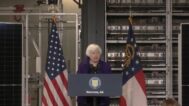
US - China
January — May 2024Ties Stabilize While Negative Undercurrents Deepen
US-China relations were marked by a paradox during the first trimester of 2024. On the one hand, a distinct stabilization was evident in ties. The two sides made concerted efforts to translate their leaders’ ‘San Francisco Vision’ into reality. Cabinet officials exchanged visits across the Pacific, working groups and dialogue mechanisms met in earnest and produced outcomes, functional cooperation was deepened, sensitive issues such as Taiwan were carefully managed, and effort was devoted to improving the relationship’s political optics. On the other hand, the negative tendencies in ties continued to deepen. Both sides introduced additional selective decoupling as well as cybersecurity measures in key information and communications technology and services sectors, with US actions bearing the signs of desinicization—rather than mere decoupling—of relevant supply chains. The chasm in strategic perception remained as wide as before. In sum, the “new normal” in US-China relations continued to take form, one piece at a time.

US - China
September — December 2023Biden-Xi Woodside Summit and the Slow Rehabilitation of US-PRC Ties
The “guardrails” that President Biden and President Xi envisaged in Bali in November 2022 began to be emplaced at their November 2023 summit in Woodside, California. In-person, leader-led communication was deepened, reassurances exchanged, and practical—albeit modest—“deliverables” locked down on several fronts, including restarting mil-mil communications, cracking down on fentanyl precursors, addressing the national security harms of artificial intelligence (AI), and increased people-to-people exchanges. The establishment of numerous bilateral working groups will ensure an almost full plate of across-the-board consultations in 2024 as well as the means to troubleshoot irritants on short notice. As stabilizing as the Woodside summit was, it failed to deflect the US-PRC relationship from its larger overall trajectory of “selective decoupling” across a range of advanced technologies and frontier industries (microelectronics; quantum; AI; biomanufacturing; clean energy). Strategic trade controls and other competitive actions were doubled down upon. With a pivotal US presidential election looming in 2024, questions abound on the longer-term durability of a rehabilitating US-PRC relationship.
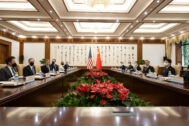
US - China
May — August 2023US-China Effort to Set “Guardrails” Back on Track for Now
The placement of the proposed “guardrails” that Joe Biden and Xi Jinping sought to erect last fall in Bali finally commenced in earnest with the visits to Beijing by three Cabinet secretaries and one National Security Council principals-level appointee. Important steps were taken to put the balloon incident behind them, with lines of communication re-opened, assurances exchanged, and incremental forward progress recorded even in areas such as export controls, where US and China had previously clashed. Defense exchanges remain an area where progress lags. Whether the “guardrails” can survive their first contact with US election year polemics remains to be seen. As ties stabilized, both sides also engaged in sanctions and countermeasures as well as domestic rulemaking to secure their national economic and security interests. All along, the administration continued building “situations of strength” with its allies and partners to shape the strategic environment around China, which Beijing viewed as an act of encirclement.
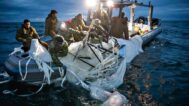
US - China
January — April 2023US-China Effort to Set “Guardrails” Fizzles with Balloon Incident
The proposed “guardrail” that Joe Biden and Xi Jinping sought to erect last fall in Bali failed to emerge in the bitter aftermath of a wayward Chinese surveillance balloon that overflew the United States and violated its sovereignty. Though Antony Blinken and Wang Yi met on the sidelines of the Munich Security Conference afterward, aspersions cast by each side against the other, including a series of disparaging Chinese government reports, fed the chill in ties. Taiwan President Tsai Ing-wen’s meeting with House Speaker Kevin McCarthy during the return leg of her US transit added to bilateral and cross-strait tensions and were met with Chinese sanctions. Issues pertaining to Taiwan, be it arms sales or a speculated Chinese invasion date of the island, remained contentious. The administration’s attempt to restart constructive economic reengagement with China, including via an important speech by US Treasury Secretary Janet Yellen, appears to have fallen on deaf ears in Beijing.
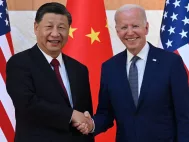
US - China
September — December 2022The Bali Summit: US and PRC Leaders Attempt to Arrest the Slide
Joe Biden and Xi Jinping met in person for the first time as national leaders at the G20 summit in Bali and agreed to manage competition in their relationship responsibly and restore regular dialogue between senior officials and cooperation between their countries. Bilateral meetings between senior officials in charge of climate, finance, trade, and defense followed. After the US announced another weapons sale to Taiwan, however, Beijing halted the resumption of military-to-military exchanges again. The US issued new export controls aimed at freezing China’s advanced chip production and supercomputing capabilities. President Biden maintained that he would send US forces to defend Taiwan if attacked and repeated that whether the island is independent is up to Taiwan to decide. The Biden administration issued its National Security Strategy, National Defense Strategy, Nuclear Posture Review, and Missile Defense Review. The US imposed sanctions on Chinese officials for serious human rights abuses in Tibet and arbitrary detention of Falun Gong practitioners. China retaliated by sanctioning two former Trump administration officials.
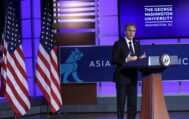
US - China
May — August 2022US-China Relations Sink Further Amid Another Taiwan Strait Crisis
Nancy Pelosi’s August visit to Taiwan—the first visit by a speaker of the US House of Representatives in 25 years—was met by a strong response from China that included provocative military exercises, punitive economic measures against Taiwan, and the suspension and cancellation of a series of dialogues with the United States. Just prior to Pelosi’s visit, Presidents Joe Biden and Xi Jinping held their fifth virtual conversation since Biden’s inauguration. Secretary of State Antony Blinken delivered a comprehensive speech on the administration’s China strategy in late May. Biden officials debated whether to lift some of the tariffs imposed on China under the Trump administration, but as of the end of August, there was no decision to do so. Human rights remained on the US agenda, with statements issued on the anniversary of the June 4, 1989 Tiananmen massacre and on the 25th anniversary of the handover of Hong Kong to the PRC, and a ban imposed on imports into the US of products made by forced labor in Xinjiang. US Secretary of Defense Lloyd Austin held his first face-to-face meeting with Chinese Defense Minister Wei Fenghe at the Shangri-La Dialogue in Singapore.
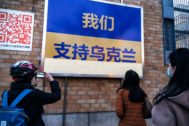
US - China
January — April 2022Putin’s War Further Strains US-China Ties
US-China relations sank to new lows in the opening months of 2022. The year began with a diplomatic boycott of the Beijing Winter Olympics by the US and nine other countries that objected to PRC policies against the Uyghurs in Xinjiang, with another five countries citing the pandemic as the reason for not sending government representatives. A meeting between Chinese leader Xi Jinping and Russian President Vladimir Putin on the eve of the Olympics produced a lengthy joint statement that highlighted the depth and breadth of the China-Russia strategic partnership and raised alarm in Washington as well as in European capitals. US-China ties soured further when the Biden administration shared intelligence with Beijing revealing that Moscow planned to invade Ukraine, but instead of seeking to prevent the war, China gave the information to Russia and refused to act. Once war broke out, US officials warned China repeatedly against providing material support to the Russian economy or military. The Chinese refused to criticize Russia, however, and instead blamed the war on the United States. US and Chinese defense chiefs held their first—and long overdue—phone call. At every opportunity, Chinese officials warned the US to stop supporting Taiwan independence. The US sent several senior delegations to Taiwan, approved the sale of $100 million in equipment and services to support the Patriot Air Defense System, and sailed three warships through the Taiwan Strait.
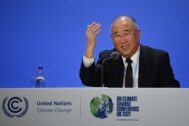
US - China
September — December 2021US and Chinese Leaders Jaw-Jaw
Joe Biden and Xi Jinping held a lengthy virtual meeting to discuss the bilateral relationship and agree on the importance of managing their competition responsibly. Demonstrating that the US and China can cooperate, the two countries signed a bilateral agreement on a common climate change agenda at COP26. USTR Katherine Tai rolled out the administration’s China trade policy. The US announced that it will not send an official delegation to the February 2022 Beijing Olympics. A few meetings were held between the US and Chinese militaries to discuss policy and operational matters. The US and its allies strongly condemned Hong Kong’s legislative elections held under new rules imposed by China that allow only “patriots” to run for office. Taiwan remained the most serious source of US-China tensions with strong warnings by both sides against challenging the interests of the other. After almost three years, Huawei Chief Financial Officer Meng Wanzhou was allowed to return to Canada in a deal struck between Meng’s lawyers and the US Department of Justice. Beijing released two Canadians who had been detained as retaliation for Meng’s arrest, and put them on a plane for Canada.

US - China
May — August 2021The Descent Continues
The downward slide in US-China relations continued as the two countries wrangled over Hong Kong, COVID-19, Taiwan, the South China Sea, Xinjiang, and cyberattacks. US Deputy Secretary of State Wendy Sherman and Chinese officials met in Tianjin but appeared to make no progress toward managing intensifying competition between the two countries. The US rolled out a series of measures against alleged Chinese forced labor practices and strengthened the prohibition against US investments in the PRC’s military industrial complex. Deteriorating freedoms in Hong Kong prompted the Biden administration to impose more sanctions on Chinese officials and issue a business advisory warning US companies of growing risks to their activities in Hong Kong.
Beijing retaliated by imposing sanctions on US citizens under its new Anti-Foreign Sanctions Law. In close coordination with its European allies, the US condemned the PRC’s use of criminal contract hackers to conduct unsanctioned cyber operations around the world, including attacks on Microsoft’s Exchange Server in March 2021. Chinese and US officials in charge of trade and economic relations held virtual meetings, but tariffs imposed by both sides during the Trump administration remained in place. Biden officials maintained that they are conducting “a robust, strategic review” of the US economic relationship with China. As the Taliban assumed control in Afghanistan, US and Chinese officials exchanged views, but the prospects for coordination and cooperation appeared dim.
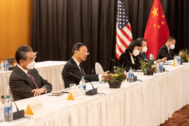
US - China
January — April 2021Continuity Prevails in Biden’s First 100 Days
In its final days, the Trump administration took more actions to impose costs on China for its objectionable policies and to tie the hands of the incoming Biden team. The first 100 days of President Biden’s administration revealed substantial continuity in policy toward Beijing, with strategic competition remaining the dominant feature of the US-China relationship. Senior Chinese officials delivered speeches that pinned blame entirely on the US for the deterioration in bilateral ties. A round of combative, yet serious, talks took place between senior US and Chinese officials in Anchorage, Alaska. The US added new sanctions on Beijing for undermining Hong Kong’s autonomy. In coordination with its allies, Washington imposed sanctions on Chinese individuals deemed responsible for carrying out genocide and crimes against humanity in Xinjiang. Steps were taken by the US to demonstrate “rock-solid” support for Taiwan in the face of stepped-up Chinese coercion. Cooperation on climate change was launched with John Kerry’s visit to Shanghai to meet with his counterpart Xie Zhenhua, and Xi Jinping’s participation in the US-led Leaders Summit on Climate.
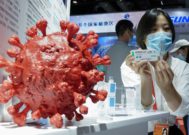
US - China
September — December 2020Joe Biden is Elected President Amid a Plummeting US-China Relationship
In the final months of 2020, the Trump administration took a dizzying number of measures aimed at accelerating economic decoupling, curtailing Chinese Communist Party influence activities in the US, punishing Beijing for undermining Hong Kong’s autonomy and carrying out human rights abuses in Xinjiang, and strengthening ties with Taiwan. The US even attempted to ban TikTok and WeChat from the US market. China took its time, but finally congratulated Joe Biden and Kamala Harris on their victory in the US presidential election. Both the US and China launched their COVID-19 vaccination campaigns. A new dialogue was launched between US and Chinese militaries on crisis communications, but the PLA later refused to attend an annual meeting of a longstanding mechanism on operational maritime safety.
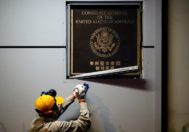
US - China
May — August 2020US-China Relations in Free Fall
President Trump blamed China for the spread of the coronavirus, which opened the door to tougher US policies on a range of issues from Hong Kong to Xinjiang. The Phase One trade deal remained intact, although Chinese purchases of US goods lagged targets in the agreement. Senior Trump administration officials delivered a series of speeches that condemned Chinese policies and suggested that the CCP poses an unacceptable threat to the United States and other democracies. Charging that the Chinese consulate in Houston was engaged in espionage, the US demanded it be closed. Beijing retaliated by shutting down the US Consulate in Chengdu. The US aligned its South China Sea policy more closely with the July 2016 tribunal ruling and declared China’s “nine-dash line” claim and actions based on it to be illegal. Tensions increased over Taiwan as the US took several steps to strengthen ties with Taipei and deter Chinese coercion. China’s imposition of national security legislation in Hong Kong resulted in the US levying sanctions on Hong Kong officials and the suspension of most US bilateral agreements with the former British Colony. A meeting between Secretary of State Mike Pompeo and Chinese Politburo Member Yang Jiechi in Hawaii did little to slow the downward slide in US-China relations.
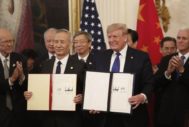
US - China
January — April 2020US-China Relations Hit New Lows Amid Pandemic
The COVID-19 virus sent US-China relations into a tailspin as 2020 opened. Recriminations flew over who was responsible for the virus that killed hundreds of thousands of people and brought economic activity to a halt. The Trump administration took a series of measures against Chinese media organizations and journalists in the United States, which provoked Beijing to expel US journalists working in China. The Phase 1 trade deal was signed, and some tariffs were lifted, though the COVID-19 outbreak hampered China’s ability to purchase the promised amount of US goods and services. With the 2020 US presidential election picking up speed, Trump campaign strategists are actively targeting China.
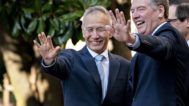
US - China
September — December 2019“Phase One” Trade Deal Reached, But Unlikely to Defuse Tensions
The US and China reached a “phase one” trade deal that includes low-hanging fruit and postpones contentious issues. Sources of friction in the bilateral relationship included President Donald Trump’s signing into law the Hong Kong Human Rights and Democracy Act, US Navy operations enforcing freedom of navigation in the South China Sea, US support for Taiwan, and China’s arbitrary detention of Xinjiang Uighurs in internment camps. A tweet by the NBA’s Houston Rockets general manager supporting protesters in Hong Kong triggered an unexpected controversy. Top US and Chinese defense leaders met on the margins of the ASEAN Defense Minister’s Meeting-Plus in Bangkok and a joint humanitarian rescue and disaster relief exercise took place in Hawaii. The US continued to take measures to crack down on Chinese espionage.
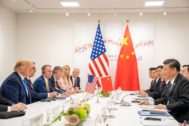
US - China
May — August 2019The Trade Deal Falls Through
US-China trade talks collapsed after China reneged on a significant portion of a draft agreement that had been painstakingly written by US and Chinese negotiators. After Donald Trump and Xi Jinping met on the sidelines of the G20 in Osaka, talks resumed but failed to make progress. Acting Secretary of Defense Patrick Shanahan met Defense Minster Wei Fenghe and both delivered speeches at the Shangri-La Dialogue in Singapore. The US sold two arms packages to Taiwan totaling over $10 billion, which included M1A2T Abrams tanks, 250 Stinger missiles, and 66 F16V fighter jets. The 26th ASEAN Regional Forum (ARF) provided an opportunity for Secretary of State Mike Pompeo and Foreign Minister Wang Yi to meet. The navies of both the US and China conducted drills in the South China Sea, and US Navy ships conducted three freedom of navigation operations (FONOPs) in the Spratlys. Pro-democracy demonstrations in Hong Kong began in early June and continued throughout the summer with spasms of violence by Hong Kong police and protesters. Beijing accused the US of being behind the protests, a charge that Washington adamantly denied.
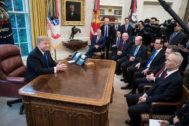
US - China
January — April 2019Is a Trade Deal Imminent?
Intense trade talks in the first four months of 2019 made progress, raising hopes that a deal will be reached in May, and signed by Presidents Donald Trump and Xi Jinping soon thereafter. Remaining sticking points include the enforcement mechanism, which is a key US demand, and a schedule for lifting the tariffs, which is a Chinese priority. The US Department of Justice unsealed an indictment charging Huawei and its CFO Meng Wanzhou with financial fraud, money laundering, obstruction of justice, sanctions violations, and other crimes. Tensions increased over Taiwan as the Trump administration took steps to strengthen ties with Taipei and warn Beijing to back off its coercive and destabilizing policies. President Trump welcomed China’s decision to add fentanyl-related substances to a supplementary list of controlled drugs and substances beginning May 1. Growing US concerns about Chinese espionage were highlighted publicly in speeches by senior Trump administration officials.
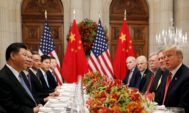
US - China
September — December 2018A Deal is Struck in Buenos Aires
On the sidelines of the G20 summit, Donald Trump and Xi Jinping put tariff hikes on hold and agreed to resume trade negotiations. Prior to the agreement, the US-China spat spilled over into the multilateral arena causing the first-ever failure to reach a joint communique at the Asia-Pacific Economic Cooperation (APEC) meeting in Port Moresby, Papua New Guinea. The imposition of sanctions by the US on the People’s Liberation Army’s Equipment Development Department and its director resulted in a temporary setback in military ties. The US took actions against Chinese individuals and hacking rings for allegedly stealing US technology to gain commercial advantage. The second US-China Diplomatic and Security Dialogue was held in Washington DC. Trump and Xi talked by phone in November and December.
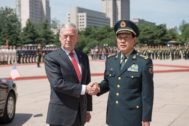
US - China
May — August 2018Tit-for-Tat Tariffs
Negotiations to resolve US-China trade friction failed to produce an agreement and the US-China trade war entered into high gear as both sides imposed tariffs on large quantities of imported goods from the other. President Donald Trump and President Xi Jinping kickstarted their relations with North Korea and held separate meetings with Kim Jong Un. Trump later accused China of undermining progress in US-North Korea negotiations. Secretary of Defense James Mattis traveled to Beijing in mid-June, the first visit to China by a US defense secretary since 2014. On Aug. 13, Trump signed into law the FY2019 National Defense Authorization Act (NDAA), which requires the president to develop a whole-of-government strategy toward China, including how to respond to China’s influence operations, cyber activities, Belt and Road Initiative (BRI), and use of economic tools to gain access to sensitive US industries. The Trump administration pushed back against Chinese bullying of Taiwan.

US - China
January — April 2018Hurtling Toward a Trade War
The US and China engaged in tit-for-tat trade actions as bilateral trade talks failed to produce a compromise. The Trump administration doubled down on its characterization of China as a threat to US interests in the National Defense Strategy and “Worldwide Threats” hearings on Capitol Hill. President Trump signed the Taiwan Travel Act, which calls for the US government to encourage visits between officials from the United States and Taiwan at all levels, provoking China’s ire. Cracks in US-China cooperation on North Korea were revealed as the Trump administration imposed sanctions on Chinese shipping and trading companies allegedly conducting illicit business with North Korea, and Beijing failed to notify Washington in advance of Kim Jong Un’s visit to China. The US conducted two Freedom of Navigation Operations (FONOPS) in the South China Sea.

US - China
September — December 2017State Visit-Plus Summit Buys Time, But Friction Mounts
Donald Trump was hosted in Beijing for a “state visit-plus” summit in early November, the third stop on his almost two week-long Asia tour. In response to North Korea’s September nuclear test and December ICBM test, the US and China worked together at the United Nations to tighten sanctions. Cracks in their cooperation widened, however, as Trump pressed Beijing to cut crude oil supplies to North Korea and Xi called for negotiations. US investigations into alleged Chinese unfair trading practices continued and remarks by Trump administration officials suggest that there is a growing possibility of the US imposing harsh trade penalties on China in 2018. Major bilateral dialogues convened in the last four months of the year included the social and people-to-people dialogue, the cyber security and law enforcement dialogue, the inaugural US-China Consultation on Foreign Nongovernmental Organization Management, and the first talks between the joint staff departments of the US and Chinese militaries. The Trump administration issued its first National Security Strategy, which depicted China as a rival and a revisionist power that, along with Russia, is seeking to erode US security and prosperity.

US - China
May — August 2017North Korea and Trade Dominate the Agenda
The Trump administration’s focus on increasing pressure on North Korea to abandon its nuclear and missile programs kept that issue at the top of the US-China agenda. In phone calls and a meeting between Presidents Trump and Xi Jinping on the margins of the G20 Summit, at the Diplomatic and Security Dialogue, and at the ASEAN Regional Forum, North Korea received the greatest attention as the US urged Beijing to use its economic leverage against Pyongyang in a bid to change Kim Jung Un’s calculus. After a seven-month hiatus, the US resumed freedom of navigation (FON) operations in the South China Sea, conducting one operation in the Spratly Islands in May and another in the Paracel Islands in July. Marine Corps Gen. Joseph Dunford made his first visit to China as chairman of the US Joint Chiefs of Staff. The first Comprehensive Economic Dialogue convened, but made little progress in easing bilateral economic friction. In August, the Trump administration formally initiated a Section 301 investigation into China’s theft of intellectual property.
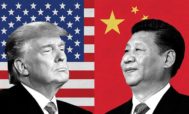
US - China
January — April 2017Trump and Xi Break the Ice at Mar-a-Lago
The US-China relationship got off to an active, albeit fitful start after Donald Trump assumed the presidency on Jan. 20. Once Trump agreed to honor the US “one China” policy, Chinese officials engaged positively with their US counterparts, and planning began for the inaugural Trump-Xi meeting. China’s top diplomat, Yang Jiechi, visited Washington at the end of February, and Secretary of State Rex Tillerson traveled to Beijing in mid-March. The highlight of this period was the Trump-Xi summit, which took place at Mar-a-Lago on April 6-7. One of the major summit deliverables was the creation of a new high-level mechanism, the US-China Comprehensive Dialogue, which will be overseen by Trump and Xi. North Korea emerged as the pressing issue for the Trump administration as well as in the bilateral US-China relationship. Trump apparently made clear to Xi that if China is unwilling to cooperate, the US would seek to solve the North Korea threat unilaterally, including by pursuing penalties against Chinese banks and companies doing business with North Korea. After the summit, Trump called Xi twice to discuss North Korea and to urge him to put greater pressure on Pyongyang.
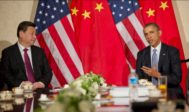
US - China
September — December 2016China Prepares for Rocky Relations in 2017
Summits between Barack Obama and Xi Jinping in September and November helped to keep tensions in check in the last four months of 2016. Despite persisting differences over how much pressure to impose on North Korea after Pyongyang conducted its fifth nuclear test, the US and China agreed on a new UN Security Council sanctions resolution. The US Navy conducted another freedom of navigation operation (FONOP) near the Paracel Islands in the South China Sea. A Chinese Navy vessel snatched a US drone, claiming it was threatening the safety of the Chinese ship and its crew, and returned it to the US five days later. Incremental progress was made on trade disputes at the 27th annual US-China Joint Commission on Commerce and Trade (JCCT) in Washington, DC. Meanwhile, the election of Donald Trump as the next US president threatened to inject significant uncertainty into US-China relations as Trump received a phone call from Taiwan’s President Tsai Ing-wen and suggested that he might use Taiwan as a bargaining chip to extract concessions from China on other issues.
US - China
May — August 2016Friction and Cooperation Advance Simultaneously
Senior US and Chinese officials publicly emphasized positive developments in the bilateral relationship at the eighth US-China Strategic and Economic Dialogue, while privately raising concerns. The second US-China Cybercrime and Related Issues High-Level Joint Dialogue convened a week later. The South China Sea persisted as a major area of tension as an UNCLOS Tribunal ruled in favor of the Philippines in its case against China. National Security Adviser Susan Rice traveled to Beijing in late July to prepare for the US participation in the G20 Summit in Hangzhou and what is likely to be the last meeting between Xi Jinping and President Obama. Bilateral military ties maintained an active pace with a visit by the US chief of naval operations to China in July, a port visit by a US guided-missile destroyer to Qingdao in August, and Chinese participation in the Rim of the Pacific (RIMPAC) military exercises in Hawaii.
US - China
January — April 2016Navigating Friction, Forging Cooperation
The South China Sea remained the most contentious issue in the US-China relationship in the early months of 2016. North Korea’s fourth nuclear test and missile launches posed both a challenge and an opportunity. After two months of intense consultations, the US and China struck a deal that led to unprecedentedly tough sanctions on Pyongyang. Xi Jinping attended the Nuclear Security Summit in Washington DC at the end of March and met President Obama. Their joint statements called for cooperation on nuclear security and climate change. Relations between the militaries hit a snag as Secretary of Defense Ashton Carter postponed a planned visit to China and Beijing rejected a request for a US aircraft carrier battle group to visit Hong Kong. Talks continued on a bilateral investment treaty, but China failed to submit a new “negative list,” leaving prospects uncertain for concluding a BIT by the end of Obama’s term.
US - China
September — December 2015Xi’s First State Visit to US: Pomp and Progress
Despite growing friction between the US and China on a number of issues, Xi Jinping’s state visit to the US in September was mostly positive and produced important outcomes on climate change, cyber security, and avoiding accidents between military aircraft. Tensions persisted in the South China Sea with China unwilling to stop its construction and militarization of terraformed reefs. The USS Lassen, a US Navy guided-missile destroyer, exercised international rights of freedom of navigation by sailing within 12nm of Chinese-occupied Subi Reef. The Obama administration notified Congress of its intent to sell a $1.83 billion arms package to Taiwan prompting Chinese objections, but no suspension of bilateral military exchanges. Presidents Obama and Xi met again on the margins of the Paris climate change conference in late November. They also conferred by phone, helping to conclude an historic, ambitious, global, agreement to reduce emissions at COP21.
US - China
May — August 2015The Run-up to Xi Jinping’s State Visit
Preparations for Chinese President Xi Jinping’s state visit to the US in September were the primary focus of the US-China relationship from May to August. The seventh Strategic and Economic Dialogue (S&ED) was held in June in an effort to tee up agreements for the summit. Friction increased on a range of issues, including China’s artificial island building in the South China Sea, Chinese cyber hacking against US companies and the US government, and repressive laws and actions undertaken by the Chinese government, some of which are likely to have negative repercussions for future US-China people-to-people exchanges. National Security Adviser Susan Rice traveled to China at the end of August to finalize deliverables for the summit amid reports of a possible Obama administration decision to impose sanctions on China for cyber-enabled theft of US intellectual property before Xi’s arrival.
US - China
January 2016 — April 2015China Makes Strides with AIIB and a Great Wall of
2015 opened with high-level exchanges in preparation for the Strategic and Economic Dialogue, scheduled for early summer, and Xi Jinping’s state visit in September. Visits to China were made by Deputy Secretary of State Tony Blinken, Treasury Secretary Jacob Lew, Commerce Secretary Penny Pritzker, and Homeland Security Secretary Jeh Johnson. Chinese State Councilor Yang Jiechi met National Security Adviser Susan Rice in New York. Military exchanges included dialogues, ship visits, joint drills, and video calls. The South China Sea remained a source of friction as evidence mounted that China is building military outposts on reefs in the Spratly Islands. In response to the issuance of the revised US-Japan Defense Guidelines, China voiced concerns and called the alliance outdated. Despite US objections, a total of 57 countries signed up to be founding members of the Chinese-led Asian Infrastructure Investment Bank. China held its annual meetings of the National People’s Congress and the Chinese People’s Political Consultative Congress, announcing an economic growth target of around 7 percent and an increase in its defense budget of 10.1 percent in 2015.
US - China
September — December 2014Summit Provides Renewed Momentum for Better Ties
The highlight of the final months of 2014 was the summit between Presidents Obama and Xi Jinping, which produced agreements on visa extensions, military confidence-building measures, climate change, and information technology. Alongside progress, tensions persisted over China’s activities in the South China Sea and its continued promotion of regional security architecture fashioned by Asian nations, with the US role unclear at best. The 25th Joint Commission on Commerce and Trade (JCCT) convened in Chicago in mid-December. The “Umbrella Movement” in Hong Kong introduced a new source of friction in the bilateral relationship as Beijing suspected Washington’s instigation behind the scenes.
US - China
May — May 2014Still Treading Water, the Sixth S&ED
The US and China held the sixth Strategic and Economic Dialogue in Beijing in July. None of the myriad of problems in the relationship were solved, but the annual meetings provided an opportunity to take stock of bilateral relations and hold high-level discussions. Tensions in the South China Sea caused by China’s deployment of an oil rig off the Paracel Islands dominated many bilateral and multilateral meetings. There were several military exchanges, with a visit to the US by Chief of the General Staff of the PLA Fang Fenghui and a visit to China by Chief of Naval Operations Adm. Jonathan Greenert. The PLA Navy participated in the US-led RIMPAC military exercises for the first time. In an incident reminiscent of the 2001 collision between a Chinese fighter jet and a US surveillance plane, a Chinese fighter flew dangerously close to a US Navy P-8 Poseidon aircraft.
US - China
January — April 2014China’s Maritime Disputes Top the Agenda
The complexity of the US-China relationship was in sharp relief in the first four months of 2014. Differences over maritime disputes along China’s eastern periphery were at the top of the agenda. Russia’s seizure of Crimea introduced a new point of contention. Despite much diplomatic activity, little progress was made on a way forward in seeking denuclearization of North Korea. US Defense Secretary Chuck Hagel made a fruitful visit to China that included very sharp exchanges with his Chinese counterparts and a tour of China’s aircraft carrier. Michele Obama along with her children and mother toured China promoting education and people-to-people exchanges. The full range of issues in the bilateral relationship was discussed by Presidents Obama and Xi Jinping when they met on the margins of the Nuclear Security Summit in The Hague.
US - China
September — December 2013Biden Visits China amid ADIZ Fracas
Bilateral interactions in the final months of 2013 were characteristically active. Secretary of State John Kerry attended the APEC Economic Leaders Meeting and the East Asia Summit in President Obama’s place, and met President Xi Jinping and Premier Li Keqiang. There were several military exchanges, including the first-ever live drill involving members of the US and Chinese armed forces. A week after the Chinese military announced the establishment of its East China Sea Air Defense Identification Zone (ADIZ), Vice President Biden visited China along with Japan and South Korea. On the economic front, the 24th Joint Commission on Commerce and Trade (JCCT) was held in Beijing. US and Chinese navy ships got within 100 yards of each other in yet another close call.
US - China
May — August 2013Sizing Each Other Up at Sunnylands
With their domestic challenges in mind and a shared need for a stable bilateral relationship, Presidents Barack Obama and Xi Jinping met for a day and a half “no necktie” official working meeting to discuss the panoply of bilateral, regional, and global issues that affect US and Chinese interests. The fifth annual Strategic and Economic Dialogue (S&ED) was held in Washington on July 10-11, along with the Strategic Security Dialogue (SSD) and the first Cyber Working Group. Cyber security, especially cyber theft, was a prominent and contentious issue, aggravated by the revelations of former NSA contractor Edward Snowden. Maritime disputes in the East and South China Seas were also a source of tension. The bilateral military relationship was a bright spot, with the visit to the US of Chinese Defense Minister Chang Wanquan.
US - China
January — April 2013Leadership Transition Ends, Interaction Picks Up
With Xi Jinping’s assumption to the presidency at the National People’s Congress, China’s leadership transition finally ended and high-level US-China contacts and exchanges picked up steam. Senior US officials traveled to China in succession to discuss urgent matters such as North Korea’s third nuclear test as well as less pressing questions such as how to define the “new type of major power relationship” between the US and China. Secretary of the Treasury Lew, Secretary of State Kerry, Chairman of the Joint Chiefs of Staff Dempsey, and Deputy Secretary of State Burns visited Beijing. North Korea’s third nuclear test provided an opportunity for the US and China to cooperate more closely. Cybersecurity rose to the top of the bilateral agenda as growing evidence revealed the extent of Chinese state-sponsored hacking into US government agencies and companies.
US - China
September — December 2012Strains Increase amid Leadership Transitions
The rare convergence of a US presidential election cycle and China’s once-in-a-decade leadership transition caused both countries to focus their energies and attention domestically in the last four months of 2012. The US held its presidential election on Nov. 6 and China held its 18th Party Congress Nov. 8-14. The reelection of President Obama was a relief for Beijing. Although China has plenty of complaints about his policies, it preferred to deal with him for another four year term, both because of the uncertainty that the election of Mitt Romney would have brought to US foreign policy and because the Chinese generally favor the status quo when it comes to US leadership. Washington was simply glad to get the Chinese leadership transition underway since it appeared that Chinese leaders and the bureaucracy were distracted and many decisions had been put on hold pending announcement of the new leadership lineup.
US - China
May — August 2012Creating a New Type of Major Power Relations
In the second trimester of 2012, the US began to flesh out its rebalancing to Asia strategy, prompting Chinese concerns. The fourth round of the Strategic and Economic Dialogue (S&ED) was held in Beijing in May amid a kerfuffle over Chinese dissident lawyer Chen Guangcheng. Presidents Barack Obama and Hu Jintao held their 12th and likely final bilateral meeting in June on the margins of the G20 Summit in Los Cabos, Mexico. Bilateral friction intensified over developments in the South China Sea. US-China military interactions stepped up with a visit to the US by Chinese Defense Minister Liang Guanglie and a visit to China by Commander of the US Pacific Command Samuel Locklear. The US-China Human Rights Dialogue was held in Washington in July.
US - China
January — April 2012Xi Visit Steadies Ties; Dissident Creates New Tensions
Xi Jinping’s visit to the US went smoothly and laid the foundation for a strong bilateral relationship after the 18th Party Congress this fall. Speeches to mark the 40th anniversary of Nixon’s visit to China highlighted progress while recognizing deep mutual strategic mistrust. The third Asia-Pacific Consultation was held to manage suspicions and enhance cooperation. President Obama met Hu Jintao on the sidelines of the Seoul Nuclear Security Summit. Friction increased with the filing of a complaint with the WTO that charged China with manipulating prices of rare earth elements. Beijing angered Washington by vetoing a UNSC resolution that called for Syria’s president to step down. But, the Council later passed a resolution that authorized observers to monitor the ceasefire. China rebuffed US entreaties to reduce oil imports from Iran and the US imposed sanctions on a Chinese company for selling refined oil to Iran.
US - China
September — December 2011US Pivot to Asia Leaves China off Balance
A spate of measures taken by the Obama administration to bolster US presence and influence in the Asia-Pacific was met with a variety of responses from China. Official reaction was largely muted and restrained; media responses were often strident and accused the US of seeking to contain and encircle China. President Obama met President Hu Jintao on the margins of the APEC meeting in Honolulu and Premier Wen Jiabao on the sidelines of the East Asia Summit. Tension in bilateral economic relations increased as the US stepped up criticism of China’s currency and trade practices, and tit-for-tat trade measures took place with greater frequency. Amid growing bilateral friction and discontent, the 22nd Joint Commission on Commerce and Trade (JCCT) convened in Chengdu, China. An announcement by the US of a major arms sale to Taiwan in September prompted China to postpone a series of planned exchanges, but the Defense Consultative Talks nevertheless proceeded as planned in December.
US - China
May — August 2011Friction and Cooperation Co-exist Uneasily
In pursuit of agreements reached between Presidents Hu and Obama in January, the US and China worked to strengthen their relationship, while managing friction on a number of issues. Renewed tensions in the South China Sea put maritime security at the top of the agenda in many bilateral and multilateral interactions, including the inaugural US-China Consultations on Asia-Pacific Affairs, at the ASEAN Regional Forum meeting in Bali, and in a bilateral meeting between Secretary Clinton and State Councilor Dai Bingguo in Shenzhen. In early May, the third annual Strategic and Economic Dialogue (S&ED) convened in Washington, DC. Despite protests from Beijing, President Obama met the Dalai Lama. In May and July, PLA Chief of the General Staff Gen. Chen Bingde and Chairman of the Joint Chiefs of Staff Adm. Mike Mullen exchanged visits. In August, Joe Biden made his first visit to China as vice president.
US - China
January — April 2011Pomp and Substance: Hu’s State Visit to the US
High-level contacts between the US and Chinese militaries resumed in January with a visit by Defense Secretary Robert Gates to China. Immediately following his trip, President Hu Jintao traveled to the US for a state visit. The occasion combined informal discussion with all the protocol trappings of a state visit by a leader from an important country. Both countries exerted great efforts to ensure the visit’s success, which put the bilateral relationship on more solid footing after a year that was characterized by increased tensions and discord. At the invitation of Secretary of State Hillary Clinton, State Councilor Liu Yandong made a week-long visit to the US in mid-April, during which she co-chaired with Clinton the second round of the Consultation on People-to-People Exchange. China held its annual “two meetings” – the National People’s Congress and the Chinese People’s Political Consultative Congress – and endorsed the 12th Five-Year Plan for National Economic and Social Development.
US - China
October — December 2010Friction and Cooperation in Run-up to Hu’s US Visit
In the final quarter of 2010, China-US relations were marked by the now familiar pattern of friction and cooperation. Tensions spiked over North Korea, but common ground was eventually reached and a crisis was averted. President Obama’s 10-day Asia tour, Secretary of State Clinton’s two-week Asia trip, and US-ROK military exercises in the Yellow Sea further intensified Chinese concerns that the administration’s “return to Asia” strategy is aimed at least at counterbalancing China, if not containing China’s rise. In preparation for President Hu Jintao’s state visit to the US in January 2011, Secretary Clinton stopped on Hainan Island for consultations with Chinese State Councilor Dai Bingguo and Deputy Secretary of State Steinberg visited Beijing. Progress toward resumption of the military-to-military relationship was made with the convening of a plenary session under the US-China Military Maritime Consultative Agreement (MMCA) and the 11th meeting of the Defense Consultative Talks. Differences over human rights were accentuated by the awarding of the 2010 Nobel Peace Prize to Chinese dissident Liu Xiaobo.
US - China
July — September 2010Tensions Rise and Fall, Once Again
Diplomatic confrontations over the Yellow Sea and the South China Sea were the source of new bilateral tensions this quarter. Beijing vigorously objected to the dispatch of the aircraft carrier USS George Washington to waters near where the South Korean corvette Cheonan sunk after being attacked in March, even before Washington had made a decision to deploy it. Worried about Chinese diplomatic posturing and destabilizing activities in the South China Sea, Secretary of State Clinton delivered a clear statement of US interests at the ASEAN Regional Forum meeting in Hanoi that irritated Beijing. With the US mid-term elections approaching, US frustration mounted over China’s unwillingness to allow its currency to appreciate against the dollar at a faster pace. The House of Representatives passed legislation that would allow the US to impose import duties on countries that have undervalued currencies. After more than five months of delay, the Pentagon submitted to Congress its annual report assessing Chinese military capabilities. Finally, two US presidential envoys traveled to Beijing to smooth over relations and President Obama met Premier Wen Jiabao on the margins on the UN General Assembly.
US - China
April — June 2010Cooperation Faces Challenges
Presidents Barack Obama and Hu Jintao met twice this quarter, first on the sidelines of the Nuclear Security Summit in Washington in April and again on the margins of the G20 Summit in Toronto in June. Nevertheless, tensions lingered over US arms sale to Taiwan and the military relationship remained suspended. The Chinese rejected a request from Secretary of Defense Robert Gates to visit China. The second round of the Strategic and Economic Dialogue was held in Beijing in late May, yielding agreements on energy, trade environment, and healthcare. Many hours were spent during the quarter in discussions between the two countries on an appropriate response to the sinking of the South Korean warship, but the gap was not narrowed. In June, China finally announced the long-awaited decision to allow its currency to be more flexible, though it remains unclear how fast and to what extent it will permit the yuan to appreciate.
US - China
January — March 2010The Honeymoon Ends
After a relatively smooth period in US-China relations through the first year of the Obama administration, the “honeymoon” ended in the first quarter of 2010. The new year brought new frictions and returned to the spotlight many problem areas. The quarter began with an unexpected announcement from an unlikely player in China-US relations: Google, the internet giant, reported extensive hacking of its networks traced back to China and then redirected Google.cn users to its Hong Kong site to evade Chinese censorship. Tensions were further stoked by the administration’s notification to Congress of a major weapons sale to Taiwan and President Obama’s meeting with the Dalai Lama. Throughout the quarter, economic frictions intensified, particularly over the valuation of China’s currency. Despite these numerous difficulties, the quarter closed with the pendulum swinging back toward the center. At the end of March, President Obama and Deputy Secretary of State James Steinberg both reaffirmed the US commitment to a positive relationship with China; Beijing announced that President Hu would attend a major international nuclear security summit in the US in April 2010; and Obama and Hu, in a friendly phone call, renewed their determination to sustain healthy and stable ties.
US - China
October — December 2009Obama-Hu Summit: Success or Disappointment?
President Obama’s first-ever trip to China was the main attraction of the fourth quarter. In addition to meeting Chinese leaders, Obama held a town hall-style assembly with Chinese students in Shanghai. The two sides signed a joint statement, the first in 12 years, which highlighted the depth and breadth of the relationship and promised greater cooperation. Nevertheless, the US media mostly faulted the president for not making sufficiently concrete progress on a number of problems. The Copenhagen climate talks garnered much attention in December. As the two largest emitters of CO2, negotiations between China and the US not only occupied the meeting’s spotlight, but also ultimately decided its outcome. Trade friction continued to intensify with both countries launching new investigations and imposing duties on several products. The bilateral military relationship took a step forward with the visit to the US by Xu Caihou, vice chairman of China’s powerful Central Military Commission.
US - China
July — September 2009Strategic & Economic Dialogue Sets Agenda for Cooperation
The inaugural session of the Strategic and Economic Dialogue was held in Washington in July, combining pomp with substantive discussions on issues of great consequence for the two countries and the world. High-level exchanges continued with the visit to the U.S. by Wu Bangguo, the head of the National People’s Congress – the first visit by China’s top legislator in two decades. A special meeting of the Military Maritime Consultative Agreement was held in Beijing to discuss the confrontations inside China’s exclusive economic zone between U.S. Navy surveillance ships and Chinese vessels that took place earlier this year. The U.S. imposed tariffs on tire imports from China, prompting Beijing to file a formal complaint against the U.S. at the WTO and launch an investigation into U.S. exports of chicken meat and auto parts. Presidents Barack Obama and Hu Jintao met in New York and both attended the G20 in Pittsburgh. They will meet again in November when Hu hosts Obama for his first visit to China.
US - China
April — June 2009Laying the Groundwork for Greater Cooperation
After the completion of the first round of “get-acquainted” meetings aimed at laying the foundation for cooperation on a broad range of issues, both the U.S. and China agree that the bilateral relationship has gotten off to a good start. While there is acute awareness on both sides of the challenges, there is a shared sense that their futures are inextricably linked and that cooperation is essential to global economic prosperity and security. The quarter opened with the first face-to-face meeting between Presidents Hu and Obama on the sidelines of the G20 financial summit in London. On separate visits to Beijing, Todd Stern, the U.S. special envoy for climate change, and House Speaker Nancy Pelosi underscored the importance of combating the effects of global warming. U.S. Treasury Secretary Timothy Geithner traveled to China to prepare for the first round of the Strategic and Economic Dialogue. Washington sought China’s cooperation on pressing regional security issues, including North Korea and Afghanistan-Pakistan. After an 18 month hiatus, the Defense Consultative Talks were held in Beijing, giving a desperately needed boost to the bilateral military relationship.
US - China
January — March 2009A Good Beginning Is Half Way to Success
The U.S.-China relationship got off to a good start under the Obama administration, putting to rest Chinese worries that a prolonged period would be required to educate the new U.S. president about China’s importance. “Positive” and “cooperative” were the two watchwords used repeatedly by Secretary of State Hillary Clinton in her discussions with Chinese leaders, which focused on the need to deepen and broaden the U.S.-China relationship, and to elevate cooperation to address urgent global problems, especially the financial crisis and global warming. In late February, U.S.-China military-to-military ties, which had been suspended by Beijing after the U.S. sold a large weapons package to Taiwan last October, partially resumed with the visit of U.S. Deputy Assistant Secretary of Defense David Sedney to Beijing. A naval confrontation between U.S. and Chinese ships took place near Hainan Island, which was quickly defused, although the underlying causes remain. Chinese Foreign Minister Yang Jiechi visited Washington D.C. in March to prepare for the first meeting between the two countries’ presidents, which took place on the margins of the G20 meeting in London on April 1.
US - China
October — December 2008Ties Solid for Transition, but Challenges Lurk
The U.S. and China held the 5th Strategic Economic Dialogue and the 6th Senior Dialogue this quarter. The global financial crisis was a focal point of discussion in both dialogues, as well as in the meeting between Presidents Bush and Hu Jintao on the sidelines of APEC in Lima, Peru. Beijing responded to the announced U.S. sale of $6.5 billion in arms to Taiwan by suspending bilateral military exchanges between the U.S. and China and talks on nonproliferation. China’s internal debate about the international structure of power and the status of the U.S. was revived as the two prepared to celebrate the 30th anniversary of the establishment of diplomatic ties.
US - China
July — September 2008Olympics Boost Chinese Pride and U.S.-China Relations
The Beijing Olympic Games were conducted without a hitch to the great relief of the Chinese leadership and the 1.3 billion Chinese people who had long anticipated the momentous event. Abroad, the reviews were mixed. Most agreed that the opening ceremony was spectacular and that China had successfully ensured the safety of the athletic competitions, but many argued that these goals had been achieved at a significant cost that highlighted the undemocratic nature of China’s regime. President Bush’s attendance further consolidated an already close and cooperative U.S.-Chinese relationship, even though Bush seized on several opportunities to criticize China’s human rights practices. The U.S.-China Joint Commission on Commerce and Trade (JCCT) marked its 25th anniversary with agreements on food security, loans for medical equipment purchase, promotion of digital TV, and cooperation in agriculture and on trade statistics. The U.S. presidential campaign heated up, but China received little attention.
US - China
April — June 2008Chock-full of Dialogue: SED, Human Rights, and Security
Major developments in Sino-U.S. relations took place on the economic, military, and political fronts this quarter. The fourth U.S.-China Strategic Economic Dialogue was held in Annapolis, Maryland, June 17-18, yielding a 10-year energy and environment cooperation framework. A telephone link was installed between the U.S. Department of Defense and China’s Ministry of Defense and talks were launched on nuclear policy and strategy. The U.S. and China held a round of their bilateral dialogue on human rights after a hiatus of six years and vice-foreign minister level talks on security issues were held for the first time in four years. The U.S. provided assistance to China to ensure the security of the 2008 Olympic Games in Beijing. A massive 7.9 magnitude earthquake rocked China’s southwestern Sichuan Province and the U.S., along with the rest of the international community, provided aid. Secretary of State Rice visited the quake-hit area and held talks in Beijing focused on North Korea.
US - China
January — March 2008Bilateral Stability, but Challenges on China’s Borders
Developments on China’s domestic front were prominent this quarter with extreme winter weather coinciding with the Spring Festival, the annual convocation of the “two meetings” in Beijing, and protests in Tibet that spread to neighboring provinces with Tibetan populations. Key events in Sino-U.S. bilateral ties included the fifth Senior Dialogue in Guiyang, a brief visit by Secretary of State Condoleezza Rice to kick-start the Six-Party Talks, and a visit by FBI Director Robert Mueller to discuss security for the upcoming August Olympic Games. In the military sphere, the Commander of U.S. Pacific Command Adm. Timothy Keating traveled to China and the Defense Policy Coordination Talks produced several agreements. Stable and complicated were watchwords for the Sino-U.S. relationship.
US - China
October — December 2007China Signals Irritation with U.S. Policy
China’s refusal to allow the USS Kitty Hawk to make a scheduled visit in Hong Kong for Thanksgiving refocused attention on bilateral differences over Taiwan and Tibet. It also raised questions about civilian-military coordination in China and highlighted the mistrust between U.S. and Chinese militaries. A series of agreements were reached to promote better relations between the U.S. and Chinese militaries during a visit to China by Defense Secretary Robert Gates and a subsequent round of the Defense Consultative Talks. Economic and trade issues were at the top of the bilateral agenda as the Joint Commission on Commerce and Trade and Strategic Economic Dialogue convened and produced some successes, although not on the niggling issue of China’s currency valuation.
US - China
July — September 2007Product Safety Plagues the Relationship
Continued recalls of Chinese-made products prompted actions by both the U.S. and China to shore up consumer confidence and enhance bilateral cooperation on food and product safety. Presidents George Bush and Hu Jintao discussed a broad range of economic and security issues on the sidelines of the APEC leaders meeting in Sydney. Treasury Secretary Henry Paulson traveled to China at the end of July to prepare for the third round of the Strategic Economic Dialogue (SED) scheduled for December amid attempts by Congress to pass legislation that would punish China if it does not revalue its currency. U.S. Chief of Naval Operations and Chairman of the Joint Chiefs of Staff- designate Adm. Mike Mullen made a six-day visit to China during which he was given unprecedented access to China’s navy.
US - China
April — June 2007Two Bilateral Dialogue Mechanisms Manage Friction
The second round of the Strategic Economic Dialogue produced a few agreements, but failed, as expected, to make headway on the contentious issue of the value of China’s currency. U.S. lawmakers on both sides of the aisle called for Beijing to take immediate steps to reduce its $232 billion trade surplus with the United States. Presidents George Bush and Hu Jintao met on the sidelines of the Group of Eight (G-8) summit in Heiligendamm, Germany. While both countries opposed Germany’s push for binding caps on greenhouse gas emissions, they continued to disagree on the degree of responsibility that emerging economies (that are among the top emitters of greenhouse gasses) should bear for reducing emissions. The failure of many Chinese products to meet safety standards became a new source of friction in the bilateral relationship. The fourth round of the Senior Dialogue provided an opportunity for high-level officials to review a broad range of bilateral, regional, and global issues.
US - China
January — March 2007Old and New Challenges: ASAT Test, Taiwan, and Trade
China’s test of an anti-satellite weapon against a defunct Chinese weather satellite on Jan. 11 prompted concern and criticism that reverberated around the world. A U.S. decision to allow Taiwan President Chen Shui-bian to make a stopover in San Francisco and notification to Congress of a possible arms sale to Taiwan led to Chinese protests. A Private Property Law was passed at the National People’s Congress along with a Corporate Tax Law. U.S. officials credited China with making positive contributions toward strengthening the international system, notably in the Six-Party Talks, but urged China to do more. In a possible signal of toughening U.S. trade policy, the Commerce Department slapped duties on imports of coated paper, reversing a decades-old policy of not applying duties to subsidized goods from non-market economies. Sino-U.S. military ties advanced with the visit to the U.S. by Gen. Ge Zhenfeng, deputy chief of general staff of the People’s Liberation Army, and the visit to China by Gen. Peter Pace, chairman of the U.S. Joint Chiefs of Staff.
US - China
October — December 2006Dialogue Boosts Ties, Even Without Results
A gaggle of Cabinet secretaries, led by U.S. Treasury Secretary Paulson, traveled to Beijing in mid-December to launch the Strategic Economic Dialogue. No breakthroughs were achieved, but both sides had low expectations for near-term results and seemed pleased with the outcome. On the North Korea nuclear front it was all bad news, with Pyongyang testing a nuclear device in early October and no tangible progress achieved at the resumption of the fifth round of Six-Party Talks after a 13-month hiatus. A positive byproduct was that intensive consultations between Washington and Beijing boosted bilateral ties. The U.S. mid-term elections that resulted in the seizure of control over both the House and Senate by the Democratic Party generated some concern in China about increased pressure on trade and human rights. On balance, however, Beijing remained confident that China-U.S. relations would remain on a positive track. Military-to-military ties continued to develop with a three-day U.S. ship visit to Zhanjiang, China, joint military exercises between the U.S. Navy and Marines and their Chinese counterparts, and a visit to China by U.S. Pacific Fleet Commander Adm. Gary Roughead.
US - China
July — September 2006Promoting Cooperation, Managing Friction
Much attention focused on economic issues this quarter with visits to China by U.S. Trade Representative Susan Schwab and U.S. Treasury Secretary Henry Paulson, which launched a new U.S.-China Strategic Economic Dialogue. Bilateral military ties also took a step forward with a visit to the U.S. by Vice Chairman of the Central Military Commission Guo Boxiong and the first ever U.S.-China joint naval exercise. Bush administration officials took China to task for continued proliferation of weapons of mass destruction (WMD) materials and technology due to lax enforcement of its export control laws. North Korea, Iran, and Sudan dominated the security agenda. The second round of the China-U.S. Global Issues Forum was held in Beijing. Bilateral space cooperation was initiated with a “get acquainted” visit to China by a delegation led by NASA Administrator Michael Griffin.
US - China
April — June 2006Pomp, Blunders, and Substance: Hu’s Visit to the U.S.
Despite the bungled welcoming ceremony on the South Lawn and the absence of concrete deliverables, the Hu-Bush summit was a modest success, given the complex nature of China-U.S. ties and the thorny issues that plague the relationship. Progress was made on market access and intellectual property rights at the Joint Commission on Commerce and Trade meeting that preceded the summit. In the wake of the summit, Beijing and Washington stepped up cooperation on both the Iranian and DPRK nuclear issues. Military exchanges were active this quarter, with a visit to China by Commander of U.S. Forces in the Pacific, Adm. William J. Fallon, the convening of the annual Defense Consultative Talks, ship visits by the U.S. Coast Guard Cutter Rush and the USS Blue Ridge, and a 10-member PLA delegation visited Guam to observe the Valiant Shield-06 military exercises. In its semi-annual report to Congress, the Department of the Treasury noted that it was “extremely dissatisfied with the slow and disappointing pace of reform for the Chinese exchange rate regime,” but refrained from citing China as intentionally manipulating its currency regime.
US - China
January — March 2006Discord on the Eve of the Bush-Hu Summit
Economic issues garnered most of the attention this quarter with U.S. officials and members of Congress pressing China to address the trade imbalance, revalue China’s currency, and curtail Intellectual Property Rights (IPR) violations in advance of Hu Jintao’s April visit to the United States. Summit preparations were conducted in high-level visits. Deputy Secretary of State Robert Zoellick met Chinese leaders in Beijing and hugged a panda in Chengdu. Chinese Vice Foreign Minister Yang Jiechi visited Washington, D.C. and urged the Bush administration to rein in Taiwan President Chen Shui-bian. Two major U.S. government reports were issued – the National Security Strategy and the Quadrennial Defense Review – both of which provoked Chinese condemnation. Beijing convened the fourth session of the 10th National People’s Congress, which focused on domestic priorities, including rural reform, education, public health, social security, and the legal system.
US - China
October — December 2005China Welcomes Bush and Ponders a U.S. Invitation to be a Responsible Stakeholder
President George W. Bush’s November visit to Beijing produced no concrete deliverables, but provided an important opportunity for U.S. and Chinese leaders to engage in a strategic conversation about the bilateral relationship and the changing world in which it is embedded. After almost six years as secretary of defense, Donald Rumsfeld traveled to China, where he sparred with Chinese military researchers from the Central Party School and the Academy of Military Sciences and became the first foreigner to visit the Second Artillery Corps. In Washington, D.C., the second round of the Senior Dialogue was held, broadening and deepening strategic discussions between senior Chinese and U.S. officials and holding out hope that a new framework for the relationship could help manage U.S. and Chinese differences.
US - China
July — September 2005Katrina Wreaks Diplomatic Havoc, Too
The quarter opened with a 20-hour stopover in Beijing by Secretary of State Condoleezza Rice. In early August, her deputy Robert Zoellick visited China to launch a senior-level dialogue on strategic issues. The devastation wrought by Hurricane Katrina resulted in the postponement of Chinese President Hu Jintao’s long-planned visit to the United States. Instead, Presidents Hu and Bush met on the sidelines of the UN General Assembly (UNGA) meeting. China played an instrumental and assertive role in forging consensus on a joint statement at the fourth round of the Six-Party Talks. U.S.-China military exchanges picked up this quarter with an exchange of visits by Gen. Liu Zhenwu, the commander of China’s Guangzhou military region, and Adm. Fallon, the commander of U.S. military forces in the Pacific. The economic and trade picture was mixed. Some progress was made on strengthening the protection of intellectual property rights in China. Three rounds of textile negotiations failed to produce an agreement. In July, China abandoned the decade-old peg of the yuan against the dollar, and revalued its currency 2.1 percent.
US - China
April — June 2005Disharmony Signals End to Post-Sept. 11 Honeymoon
America’s grievances with China mounted this quarter, signaling a likely end to the post-Sept. 11 honeymoon in China-U.S. relations and the beginning of a rocky phase. On a range of trade and economic issues, the Bush administration adopted a harsher stance, increasing pressure on Beijing to appreciate its currency to fend off criticism from Congress and domestic groups that blame China for stealing U.S. jobs and unfairly creating a massive trade surplus with the United States. Trade officials began taking action to curtail the flood of Chinese textiles and punish China for widespread violations of intellectual property rights. A takeover bid for Unocal Corporation by the PRC’s state-owned China National Offshore Oil Company (CNOOC) raised cries in some quarters that Beijing’s offer was part of a long-term national plan to gain strategic advantage over the U.S.
Washington leaned harder on Beijing to apply economic and diplomatic pressure on North Korea to rejoin the Six-Party Talks aimed at eliminating its nuclear weapons programs. U.S. officials openly declared that they hold China largely responsible for reining in the nuclear ambitions of its formerly “close as lips and teeth” ally, North Korea.
China’s military buildup also came under sharper criticism. Defense Secretary Donald Rumsfeld bluntly warned Beijing that its military spending and procurement programs are unjustified by any threat it faces. And China’s human rights abuses and suppression of political dissent and religious freedom figured prominently in U.S. official statements and reports issued this quarter.
Mindful of the benefits to the U.S. of cooperation with China where the two countries’ interests overlap and the dangers of engaging in full-blown strategic competition with China, President Bush and his Cabinet members attempted to keep the bilateral relationship on an even keel, while urging Chinese leaders to modify their policies to make them more compatible with U.S. national interests.
US - China
January — March 2005Rice Seeks to Caution, Cajole, and Cooperate with Beijing
President Bush’s second term opened with an active agenda of bilateral U.S.-China interactions. Secretary of State Condoleezza Rice traveled to Beijing on a six-nation tour of South and East Asia during which she sought to enlist China’s help in exerting pressure on North Korea to give up its nuclear weapons. China’s National People’s Congress passed an anti-secession law that the Chinese government viewed as reasonable and necessary, but U.S. officials characterized as “unhelpful” and likely to increase cross-Strait tensions. Urging China to enhance its protection of intellectual property rights (IPR) was the central task of outgoing U.S. Secretary of Commerce Donald Evans’ visit to Beijing. Deputy Under Secretary of Defense Richard Lawless conducted the first ever “special policy dialogue” between the two militaries. Senior U.S. officials voiced concern about China’s military buildup and its proliferation activities, and strongly opposed the lifting of the EU’s 15-year old arms embargo on China.
US - China
October — December 2004Slips of the Tongue and Parables
The quarter opened with a visit by Secretary of State Colin Powell to Beijing, as well as Seoul and Tokyo, that did little to jumpstart the stagnant Six-Party Talks or revive the dormant dialogue between Taiwan and China. Controversy erupted over statements Powell made to the media that endorsed peaceful reunification of the two sides of the Strait and declared that Taiwan does not enjoy sovereignty. Hu Jintao and George W. Bush talked by phone in October and November, and then met on the sidelines of the 12th APEC summit in Santiago, Chile. Although cooperation predominated between Washington and Beijing, differences persisted on numerous issues, including China’s proliferation activities, U.S. refusal to return to China exonerated Uighurs held in Guantanamo Bay, the European Union arms embargo on China, Iran’s nuclear programs, China’s human rights practices, China’s currency, and the mushrooming bilateral trade deficit.
US - China
July — September 2004Rice Visits Beijing, but Disappoints Her Hosts
After years of entreaties by China to make a solo trip to the Middle Kingdom, National Security Adviser Condoleezza Rice unexpectedly decided to visit Beijing as well as Tokyo and Seoul in early July. Chinese leaders failed in their efforts to extract a commitment to reduce U.S. arms sales to Taiwan and intensify pressure on Taiwan President Chen Shui-bian to refrain from taking provocative steps toward the establishment of a legally independent state. The third visit to China by Chief of the U.S. Pacific Command Adm. Thomas Fargo was also dominated by discussions about the Taiwan Strait. The U.S. and China faced off in the United Nations Security Council twice this quarter over how to respond to the escalating violence in Sudan. China’s foreign minister personally complained about the alleged beating of a Chinese citizen by officers of the U.S. Customs and Border Protection in Niagara Falls near the U.S.-Canadian border in late July. Finally, Beijing awaits the U.S. presidential elections with trepidation and ambivalence.
US - China
April — June 2004Anxiety About Taiwan Hits New Highs
Vice President Dick Cheney made a long-awaited visit to China this quarter and engaged in strategic dialogue with China’s top leaders, who underscored the dangers of Taiwan independence in the aftermath of the re-election of Taiwan’s President Chen Shui-bian. Despite U.S. efforts to allay Beijing’s fears, Chinese dissatisfaction with U.S. policy toward Taiwan spilled over into other policy arenas, influencing its handling of Iraq and North Korea. This quarter also saw a host of activity in the economic realm, with the convening of the 15th U.S.-China Joint Commission on Commerce and Trade, June visits to China by U.S. Secretary of Labor Elaine Chao and U.S. Secretary of Commerce Don Evans, and the signing of numerous bilateral economic agreements.
US - China
January — March 2004A Familiar Pattern: Cooperation with a Dash of Friction
U.S. and Chinese diplomats shuttled to each other’s capitals for consultations this quarter on a rich agenda of bilateral issues and regional and international security matters, including North Korea, Iraq, Libya, Iran, Taiwan, and curbing proliferation of weapons of mass destruction. The pace of China-U.S. military exchanges accelerated with visits to Beijing by the Chairman of the Joint Chiefs of Staff Gen. Richard Meyers, the holding of the Defense Consultative Talks, and a U.S. port call to Shanghai. At the same time, friction mounted on trade and human rights as the U.S. filed the first case against China at the World Trade Organization (WTO) and introduced a resolution condemning Chinese human rights practices for the first time in three years at the UN Commission on Human Rights in Geneva. The disputed presidential election in Taiwan captured attention and elicited concern in both Beijing and Washington, although their responses diverged considerably.
US - China
October — December 2003Wen Jiabao’s Visit Caps an Outstanding Year
The year 2003 closed with two high-level visits. Chinese Premier Wen Jiabao toured three cities on the U.S. east coast and was received at the White House with a 19-gun salute. Wen cemented the visit’s success and boosted his position back home when President Bush stood by his side and rebuked Taiwan President Chen Shui-bian for seeking to change the status quo in the Taiwan Strait. But there was little progress made on important issues such as China’s burgeoning trade surplus with the U.S. and North Korea’s nuclear weapons. Chinese Defense Minister and Vice Chairman of the Central Military Commission Cao Gangchuan was hosted by Defense Secretary Donald Rumsfeld. Presidents Bush and Hu Jintao met early in the quarter on the sidelines of the APEC summit.
US - China
July — September 2003The Best since 1972 or the Best Ever?
Continued cooperation on security matters, especially the challenge posed by North Korea’s nuclear weapons programs, bolstered U.S.-China relations this quarter. Washington lauded China’s vigorous diplomatic efforts that culminated in the holding of six-party talks in Beijing at the end of August. China formally joined the Container Security Initiative (CSI), agreeing to permit U.S. Customs and Border Protection officials to work side-by-side with their Chinese counterparts to target and pre-screen cargo containers shipped from Shanghai and Shenzhen destined for the United States. U.S. officials publicly rebuked Beijing for not living up to its promises made last December to make progress on specific human rights issues. Treasury Secretary John Snow visited Beijing and tried, but failed, to persuade Chinese officials to appreciate the renminbi (RMB). The Department of Defense released its annual report on July 30 on Chinese military power.
US - China
April — June 2003SARS, Summitry, and Sanctions
Although Beijing was distracted this quarter by the SARS epidemic, there was still progress in U.S.-Chinese relations. Dealing with North Korea’s nuclear weapons programs continued to top the bilateral diplomatic agenda with China orchestrating and hosting trilateral talks in Beijing. Presidents Bush and Hu Jintao agreed to seek a peaceful solution to the nuclear weapons issue in a summit on the sidelines of the G-8 meeting in Evian and exchanged views on other international and bilateral issues. In an unprecedented joint effort between the U.S. Drug Enforcement Administration (DEA) and law enforcement authorities in China and Hong Kong, the U.S. and China succeeded in dismantling a massive heroin smuggling organization that targeted the U.S. and Canada. On the negative side of the ledger, the U.S. expressed displeasure at Beijing’s lax enforcement of its export control laws, promulgated almost one year ago, by slapping sanctions on Norinco, one of China’s biggest and most prestigious state-owned conglomerates.
US - China
January — March 2003China and the U.S. Disagree, but with Smiles
A flurry of diplomatic activity took place this quarter as Chinese and U.S. officials conferred on how to compel Iraqi President Saddam Hussein to relinquish his weapons of mass destruction and manage the emerging crisis over the North Korean nuclear weapons programs. Beijing opposed the U.S. military strike on Iraq, but was cautious to prevent its antiwar position from damaging the bilateral relationship. U.S. and Chinese presidents engaged in telephone diplomacy and U.S. Secretary of State Colin Powell consulted frequently with Chinese Foreign Minister Tang Jiaxuan on the sidelines of meetings at the United Nations in New York. United States Trade Representative Robert Zoellick visited China to discuss the repercussions of its entry into the World Trade Organization (WTO), ongoing Chinese economic reforms, bilateral trade issues, and current global trade negotiations. Cooperation on counterterrorism advanced with the convening of the third U.S.-China antiterrorism consultation and the second meeting on cutting financial fund links to terrorists.
US - China
October — December 2002Sustaining Cooperation: Security Matters Take Center Stage
This quarter opened with summitry as Presidents George W. Bush and Jiang Zemin held their third meeting at Bush’s ranch in Crawford, Texas. Their discussion and subsequent U.S.-Chinese consultations covered a broad range of issues, but security matters received special attention as North Korea acknowledged a previously unknown uranium-enrichment program and the Bush administration stepped up its efforts to disarm Iraq. Beijing issued new export control regulations for all major categories of weapons of mass destruction (WMD), bringing China into closer adherence with international nonproliferation export control standards. Bilateral human rights talks took place for the first time in over a year and produced an agreement by China to invite UN investigators into the country to examine allegations that it jails people without due process, restricts freedom of religion, and allows torture in its prisons. High-level military contacts also resumed with the convening of the fifth Defense Consultative Talks and a visit to China by Commander, U.S. Pacific Command Adm. Thomas Fargo.
US - China
July — September 2002Playing up the Positive On the Eve of the Crawford Summit
Preparation for the U.S.-China October summit between Presidents George W. Bush and Jiang Zemin in Crawford, Texas proceeded smoothly this quarter. During Deputy Secretary of State Richard Armitage’s August visit to Beijing, the United States and China exchanged positive gestures. Washington endorsed China’s claim that at least one separatist group in Xinjiang has links to the al-Qaeda terrorist network and announced that its assets in the United States would be frozen. The Chinese in turn released new rules on the export of missile technology and a missile technology control list. Both countries signaled their growing satisfaction with bilateral cooperation in the counterterrorism arena. A crisis was averted over Taiwan President Chen Shui-bian’s Aug. 3 statement that there is “one country on each side” of the Taiwan Strait.
The mid-July release of two reports on China, one by the Department of Defense and the other by a bipartisan congressional commission, stirred concern in China. Overall, relations improved as both Beijing and Washington advanced their respective interests by emphasizing the positive elements of their relationship.
An active agenda of exchanges and consultations took place this quarter, providing Sino-U.S. relations with a modicum of stability as Washington focused on the war on terrorism and other foreign policy priorities. Chinese Vice President Hu Jintao toured the United States, stopping in Washington for two days of meetings with President George W. Bush, Vice President Dick Cheney, and many Cabinet members. Cooperation between Washington and Beijing in the war on terrorism advanced with the establishment of semi-annual consultations on depriving terrorist networks of their sources of financing. Broader discussions on combating terrorism were also held in the second round of bi-annual U.S.-Chinese counterterrorism talks. Sessions were held of the Joint Commission on Economic Cooperation and Trade and the Joint Commission Meeting on Science and Technology, providing a boost to commercial and economic ties. Beijing remained both suspicious and perplexed by U.S. policy toward Taiwan, and verbal gaffes by President Bush and Deputy Secretary of Defense Paul Wolfowitz created unease on both sides of the Strait. Finally, representatives from the U.S. and Chinese militaries explored the possibility of resuming contacts.
US - China
January — March 2002Two Steps Forward, One Step Back
U.S. President George W. Bush’s visit to Beijing, Feb. 21-22, was the highlight of Sino-U.S. relations in the first quarter of 2002. President Bush and PRC President Jiang Zemin held in-depth discussions on a broad range of international and bilateral issues and both reaffirmed their commitment to a “constructive, cooperative” relationship. They agreed to intensify high-level strategic dialogue and expand bilateral exchanges and cooperation in the areas of economy and trade, energy, science, and technology, environmental protection, the prevention of HIV/AIDS, counterterrorism, and law enforcement. Differences persisted over nonproliferation, Taiwan, human rights, and religious freedom. In March, following talks in Washington between Chinese and U.S. officials in charge of nonproliferation matters, there were signs that modest progress might be forthcoming later this year in the dispute over Chinese export controls and sales of missile technology. Improvement in the relationship was to some extent set back by Taiwan’s Defense Minister Tang Yiau-ming’s visit to Florida to attend a unofficial conference that included senior Bush administration officials. In protest, Beijing canceled a Chinese Navy ship visit to the United States planned for the latter half of 2002.
US - China
October — December 2001Face to Face in Shanghai: New Amity amid Perennial Differences
The re-ordering of U.S. security priorities in the wake of the Sept. 11 terrorist attacks provided an opportunity for Washington and Beijing to work together toward a common goal. Cooperation against terrorism and the successful first-ever meeting of U.S. President George W. Bush and PRC President Jiang Zemin at the Asia Pacific Economic Council (APEC) Leaders’ Meeting in Shanghai contributed to an improvement in the overall atmosphere of the Sino-U.S. relationship in the final quarter of 2001. At the same time, however, friction between the two countries persisted on issues of long-standing controversy, including human rights, nonproliferation, missile defense, and Taiwan. After 15 years of negotiations, China finally joined the World Trade Organization (WTO), bringing a market of 1.3 billion people into the global trading system.
US - China
July — September 2001Terrorist Strikes Give U.S.-China Ties a Boost
The Sept. 11 terrorist attacks on the World Trade Center and the Pentagon provided a new strategic focus for U.S.-China relations. Chinese President Jiang Zemin immediately condemned the terrorist actions and offered China’s support for the Bush administration’s global counterterrorism effort. A week following the attacks, Chinese Foreign Minister Tang Jiaxuan arrived in Washington to prepare for President Bush’s late October summit with President Jiang that was to be held in Beijing following the Asia Pacific Economic Cooperation (APEC) Leaders’ Meeting in Shanghai. After the Tang visit, Beijing sent a delegation of counterterrorism experts to share intelligence with U.S. officials that might aid the Bush administration’s war on terrorism. An important step aimed at avoiding future mid-air collisions was taken when Chinese and American military delegations met on Guam in a special meeting of the Military Maritime Consultative Agreement (MMCA). Earlier in the quarter, discord over China’s alleged transfer of missile components to Pakistan that resulted in the imposition of sanctions on a Chinese company. U.S. Secretary of State Powell traveled to Beijing in July for talks with Chinese leaders and reassured the Chinese people that the United States views China as a friend, not as an adversary.